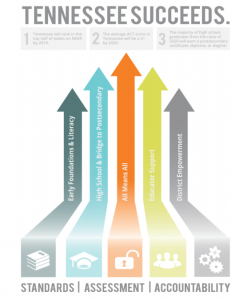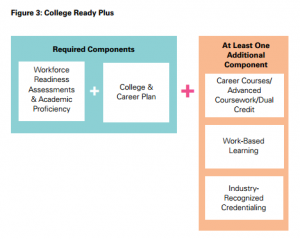Transition Update from the Trump Administration
 After a contentious confirmation hearing and an unprecedented vote requiring Vice President Mike Pence to break a Senate tie, Betsy DeVos was confirmed as President Donald Trump’s Secretary of Education on February 7. In her first weeks on the job, Secretary DeVos reassured state education officials they should move forward with implementing the Every Students Succeeds Act (ESSA) as planned, despite moves from the 115th Congress to eliminate Obama-era regulations on ESSA accountability and teacher preparation. Barring further changes from the administration, state ESSA plans are due on either April 3 or September 18 this year.
After a contentious confirmation hearing and an unprecedented vote requiring Vice President Mike Pence to break a Senate tie, Betsy DeVos was confirmed as President Donald Trump’s Secretary of Education on February 7. In her first weeks on the job, Secretary DeVos reassured state education officials they should move forward with implementing the Every Students Succeeds Act (ESSA) as planned, despite moves from the 115th Congress to eliminate Obama-era regulations on ESSA accountability and teacher preparation. Barring further changes from the administration, state ESSA plans are due on either April 3 or September 18 this year.
Meanwhile, the Senate voted by a narrow 51-49 margin to confirm former congressman Mick Mulvaney to head President Trump’s Office of Management and Budget. It is unclear at the moment exactly how Mulvaney will influence the budget and appropriations process moving forward, though he has advocated widespread cuts to federal spending. Mulvaney’s first task will be releasing the administration’s budget priorities for fiscal year 2017 and 2018. While FY18 begins in October this year, the federal government is operating under a continuing resolution (CR) that expires on April 28. Congress will need to either pass a new CR or put together an omnibus budget bill by that date to keep the government running through the fall. Advance CTE has been closely monitoring budget and appropriations efforts and will report back as more information comes available.
Buzz on the Hill around CTE Month
This year’s CTE Month – an annual celebration of Career Technical Education (CTE) – coincides with the 100-year anniversary of the Smith-Hughes Act. On the Hill, there is growing enthusiasm and recognition of the progress CTE has made over the past century. Last week, the Senate passed a resolution praising CTE for helping students develop the skills and abilities they need to be successful in the workforce. The resolution garnered a record 31 co-sponsors before it was passed.
Also, a Valentine’s-Day CTE Caucus event celebrating the past, present and future of CTE drew a crowd. Advance CTE’s very own Kimberly Green spoke on the panel, sharing the history of federal involvement in CTE from Smith-Hughes through today. A video of the event is available here.
Perkins Reauthorization A Top Priority for 115th Congress
Members of the House Education and Workforce Committee are coalescing around a possible springtime reauthorization of the Carl D. Perkins Career and Technical Education Act (Perkins). In an op-ed for Real Clear Education, Chairwoman Virginia Foxx (R-NC) wrote that passing an updated Perkins Act was a top priority for her committee, one she aims to “finish … in the coming months.” The Committee has scheduled a hearing on strengthening CTE at the secondary level for February 28 and is rumored to be planning to reintroduce a bill that is in close proximity to last year’s H.R. 5587 shortly thereafter. That bill passed the House in September on a 405-5 margin but stalled in the Senate.
Perkins reauthorization is top of mind for the nascent Trump administration as well. Speaking at the 2017 Community College National Legislative Summit, Secretary of Education Betsy DeVos remarked:
I know that there are many items on your legislative agenda, from reauthorization of the Higher Education Act and the Perkins Act, to ways community colleges can help transform the nation’s infrastructure, to allowing Pell Grants to have flexibility in supporting students working to graduate more quickly. And in the days ahead, I’ll look forward to hearing your thoughts and working with you as President Trump’s vision continues taking shape.
As always, subscribe to our Legislative Update blog series for the latest updates on Perkins and other federal activities related to CTE.
Austin Estes, Policy Associate



 In the nine months since President Obama signed the Every Student Succeeds Act (ESSA) into law last December, states and policymakers have been hard at work digging through the legislation and deciding how to structure their new plans. ESSA, which reauthorized the Elementary and Secondary Education Act, presents a number of opportunities to expand access to high-quality Career Technical Education (CTE). As states prepare to implement the law next year, we will provide periodic updates on their progress and share strategies for leveraging ESSA to support CTE at the state level.
In the nine months since President Obama signed the Every Student Succeeds Act (ESSA) into law last December, states and policymakers have been hard at work digging through the legislation and deciding how to structure their new plans. ESSA, which reauthorized the Elementary and Secondary Education Act, presents a number of opportunities to expand access to high-quality Career Technical Education (CTE). As states prepare to implement the law next year, we will provide periodic updates on their progress and share strategies for leveraging ESSA to support CTE at the state level. A
A 
